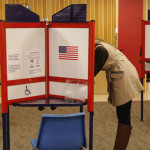
When I registered to be a poll worker in this year’s general election, I did so because I wanted to see Inclusion Solutions’ products in action. When your job requires you to tell your products’ story, it’s a heck of a lot easier to tell an interesting one when you have hands-on experience with your products after they’ve left the warehouse.
Contrary to what some people might think, poll workers are not volunteer positions in Cook County, Illinois. Individuals are paid $190 to attend a three-hour training class and work the poll from 5:00 a.m. to 7:00 p.m. Yes, it’s a long day. But registration was easy. I signed up online and was assigned to a poll worker training class close to home. I heard from a colleague at work many individuals “drop in” on these training classes, and so I arrived early to guarantee my spot. For the record, this was good advice. Many eager wanna-be poll workers did in fact drop in (whether for the money or the glory – who’s to say?).
I can’t articulate exactly what I was expecting from this training class other than the obvious – learn how to be a poll worker, but pretty much everything about the experience was a surprise. First up? My fellow classmates. The attendees were a wonderfully diverse group of individuals, and I couldn’t help but think that of course something as American as a democratic election would in fact reflect the make-up of America. Students and senior citizens? Check. Men and women? Present and accounted for. Multiple races and ethnicities? Emphasis on the multiple. And in a nod to some of this election year’s more controversial headlines, the delightful woman sitting next to me (a veteran poll worker, actually) was dressed in a hijab.
Next up? The course content. Let’s just say I have a newfound respect for the complexity of our elections process. There are plans, and then there are back-up plans. And then there are back-up plans for those back-up plans! And I understand why. If something goes awry on November 8, there’s no do-over.
From a “serve the voter” perspective, we covered every possible scenario: polling place accessibility, polling place security, voter assistance procedures, accommodating young children accompanying parents and caregivers, voter conduct in the polling place (i.e., campaigning, taking pictures – I’m talking to you Justin Timberlake!). Sounds like a lot? Believe me when I say those were just the tip of the iceberg.
And then we learned how to open and close the polls, set up and place the voting booths, hang appropriate signage, set up tables and scanners, issue ballots, and process provisional voters. The curriculum thoroughly covers all applicable laws and procedures. Describing the material as “dense” and “highly technical” would be, quite frankly, an understatement. In fact, I decided the magic number at poll worker training is “100.” How many pages in the training manual? 100. How many pieces of equipment in the voting equipment box? 100. How many steps to follow when accounting for a voter? 100.
I jest, of course, but one of my key takeaways: while precision is paramount, it is seemingly unattainable. I was amazed by how labyrinthine the system is. A single registered voter is accounted for and “tracked” in multiple places (exponentially more for a first-time voter needing to present identification, an unregistered voter, a voter who lost his/her mail-in ballot, a voter who walked in with a mail-in ballot, etc.). We were given a test at the end of the class on all of the material we learned, and testament to how elaborate the process is – many did not pass.
I left training with a much better appreciation for the individuals who volunteer their time and spend their energy in the polls on Election Day. Approximately two million Americans are necessary to work the polls in a general election year, and the average age of these individuals is 72. In order to meet voters’ basic needs such as opening the polls on time and facilitating an expedient voting experience, these women and men attended a training class fairly similar to the one I described above, which was exhausting. There is much to coordinate, and much that can go awry. It never occurred to me before to bring coffee and snacks to the poll workers in my precinct, but it certainly does now (hint to all you readers)! This team is instrumental in the elections process and yet largely unrecognized.
As November 8 approaches, one question remains. Does the herculean task of making it possible for hundreds of people to vote leave poll workers disinterested in the actual election results? I shall see. (Though perhaps not in this election!)